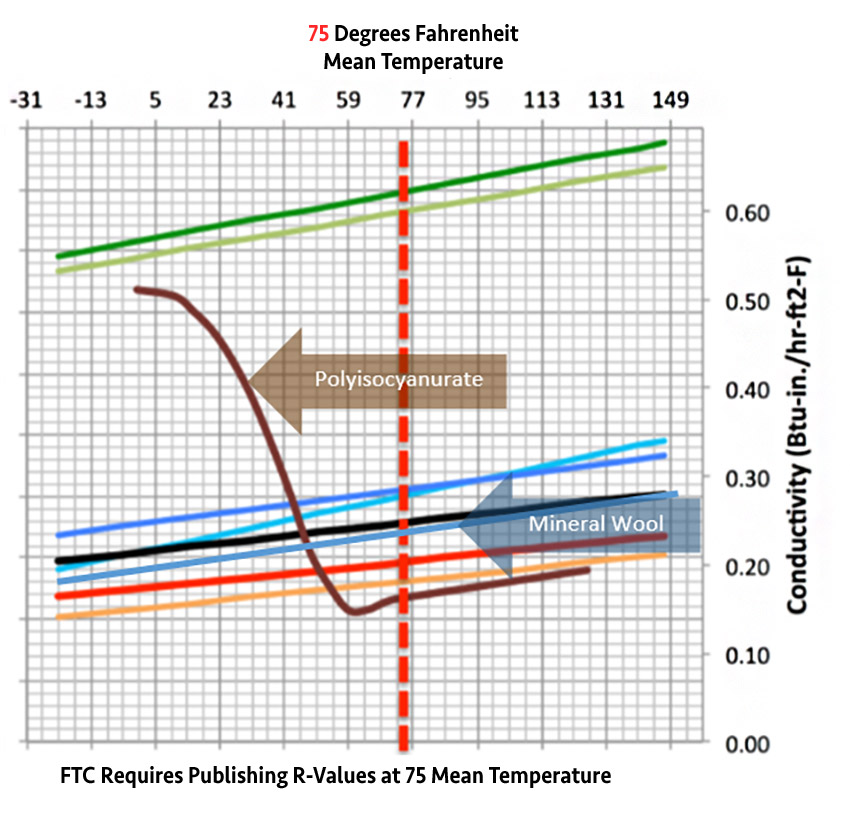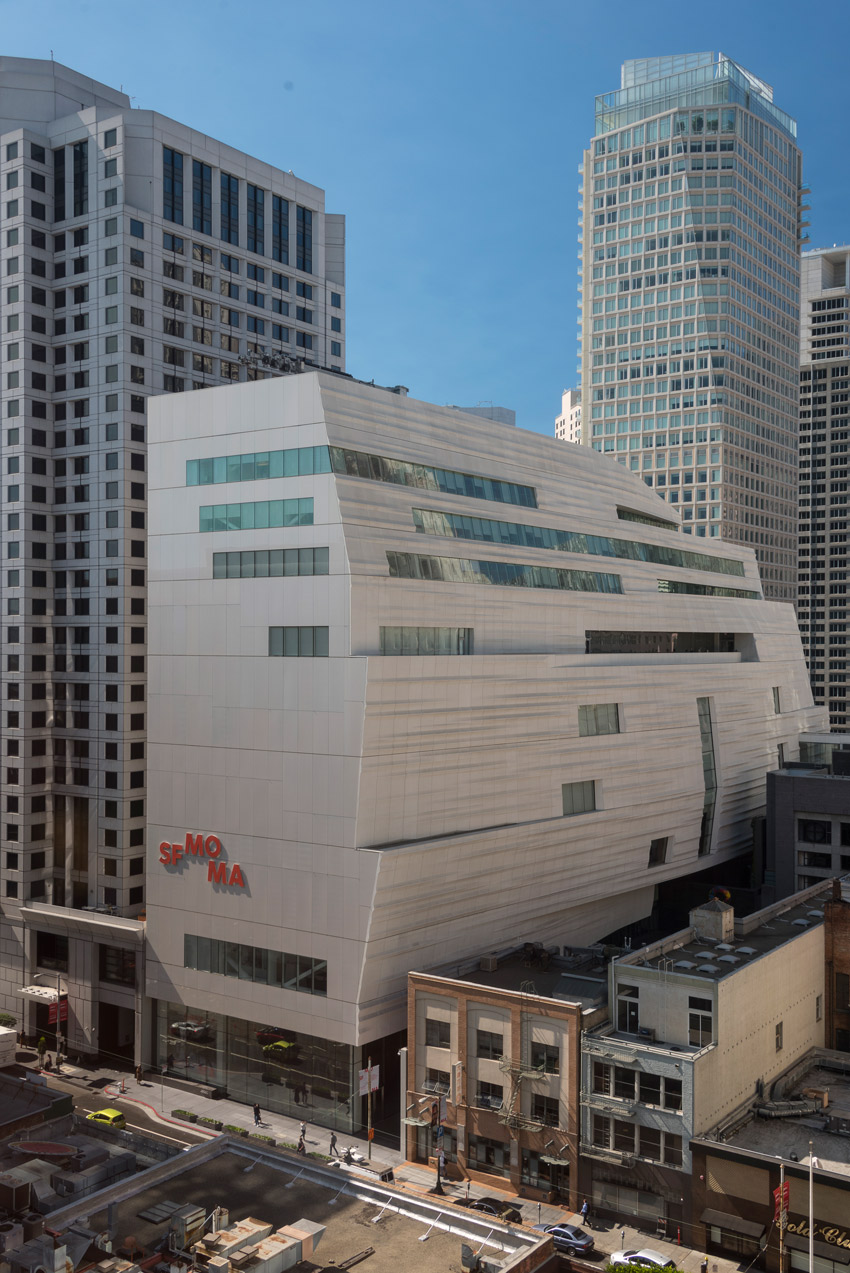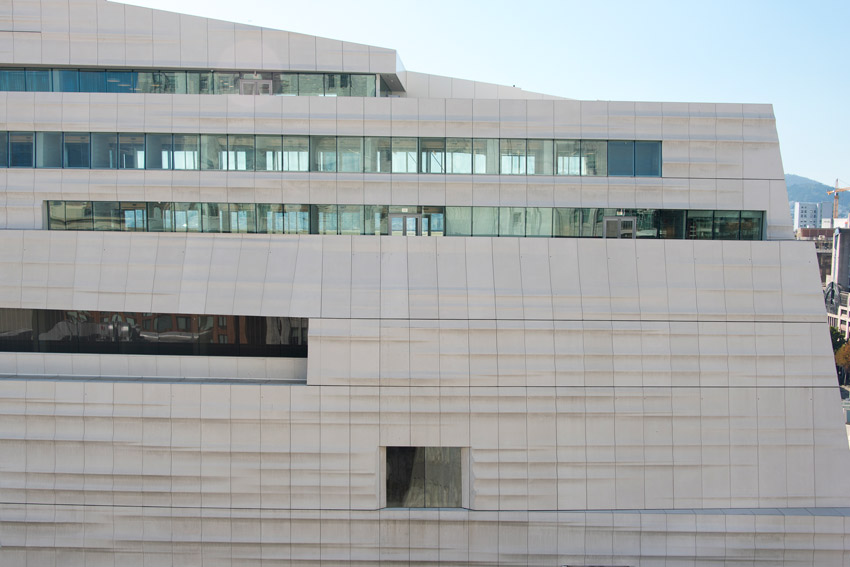Mineral Wool as a Continuous Insulation Solution
Providing a host of benefits while meeting stringent code requirements for energy-efficient building design
![]() Continuing Education
Continuing Education
Use the following learning objectives to focus your study while reading this month’s Continuing Education article.
Learning Objectives - After reading this article, you will be able to:
- Identify the advantages and implications of using continuous insulation (ci) in energy-efficient exterior wall design and construction.
- Discuss key building and energy code requirements related to the use of continuous insulation.
- Explain the raw materials used to manufacture mineral wool ci as well as its manufacturing process.
- Describe the many benefits of mineral wool ci in sustainable, exterior wall assemblies.
When designing exterior wall assemblies, selecting the type and placement of insulation within the wall is critical. Not only can insulation have a significant impact on the overall energy efficiency of a building, but it can also help minimize the spread of fire, manage risks associated with moisture and mold, improve occupant comfort, and more.
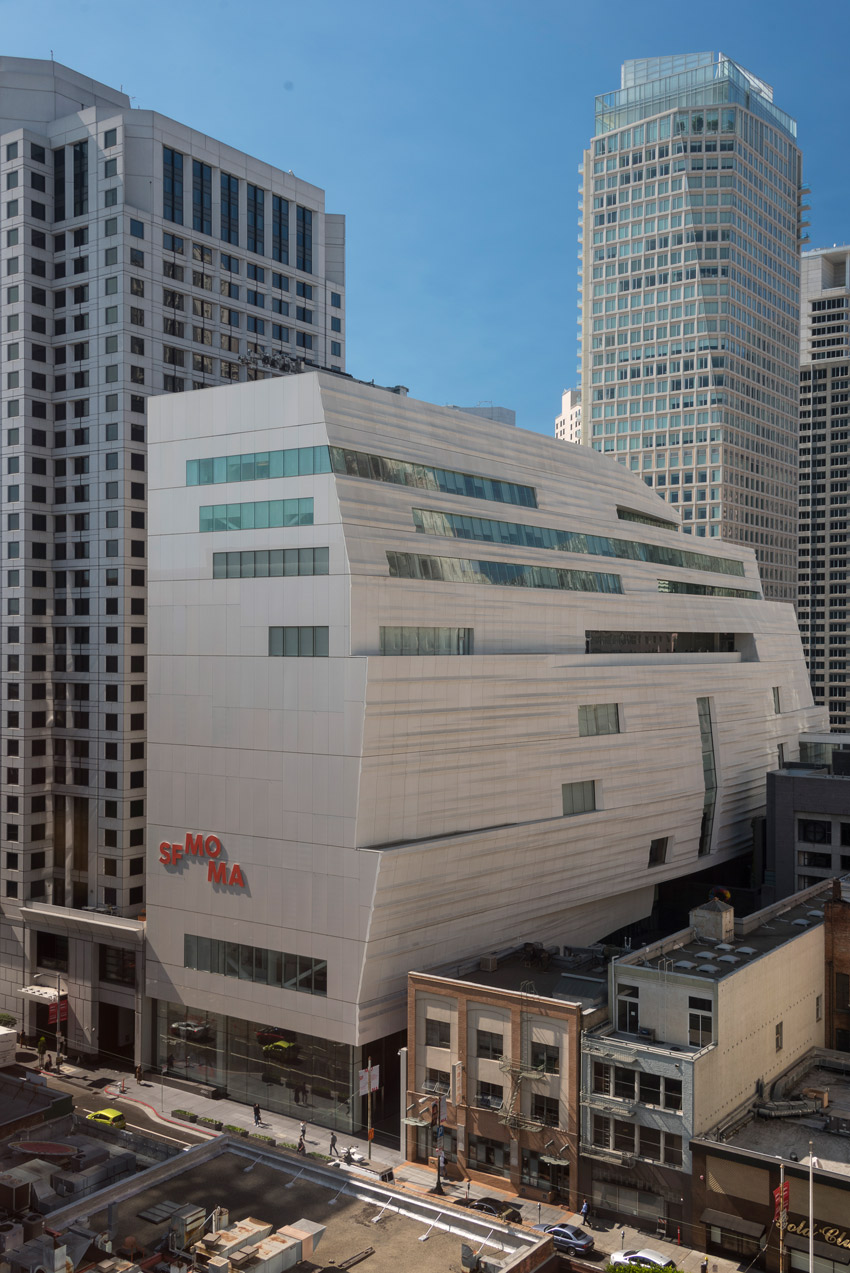
All Images courtesy of Owens Corning
Four different mineral wool solutions were used in the expansion of The San Francisco Museum of Modern Art (SFMOMA), which reopened in May 2016 following three years of construction.
To address thermal performance, wall systems almost always feature insulation batts, which are friction fit in between framing members. However, depending on the climate zone and construction type, insulation batts alone may not provide enough thermal resistivity to meet the thermal requirements prescribed in the energy codes. Accordingly, there has been a substantial increase in the use of continuous insulation, which can be used in conjunction with insulation batts to optimize thermal performance.
These changes represent a positive shift in wall design; however, the inclusion of continuous insulation does have important implications and raises new questions for AEC professionals. For starters, what is continuous insulation?
Continuous Insulation Defined
The ASHRAE 90.1 energy standard defines continuous insulation as “insulation that is continuous across all structural members without thermal bridges other than fasteners and service openings. It is installed on the interior, exterior, or is integral to any opaque surface of the building envelope.”
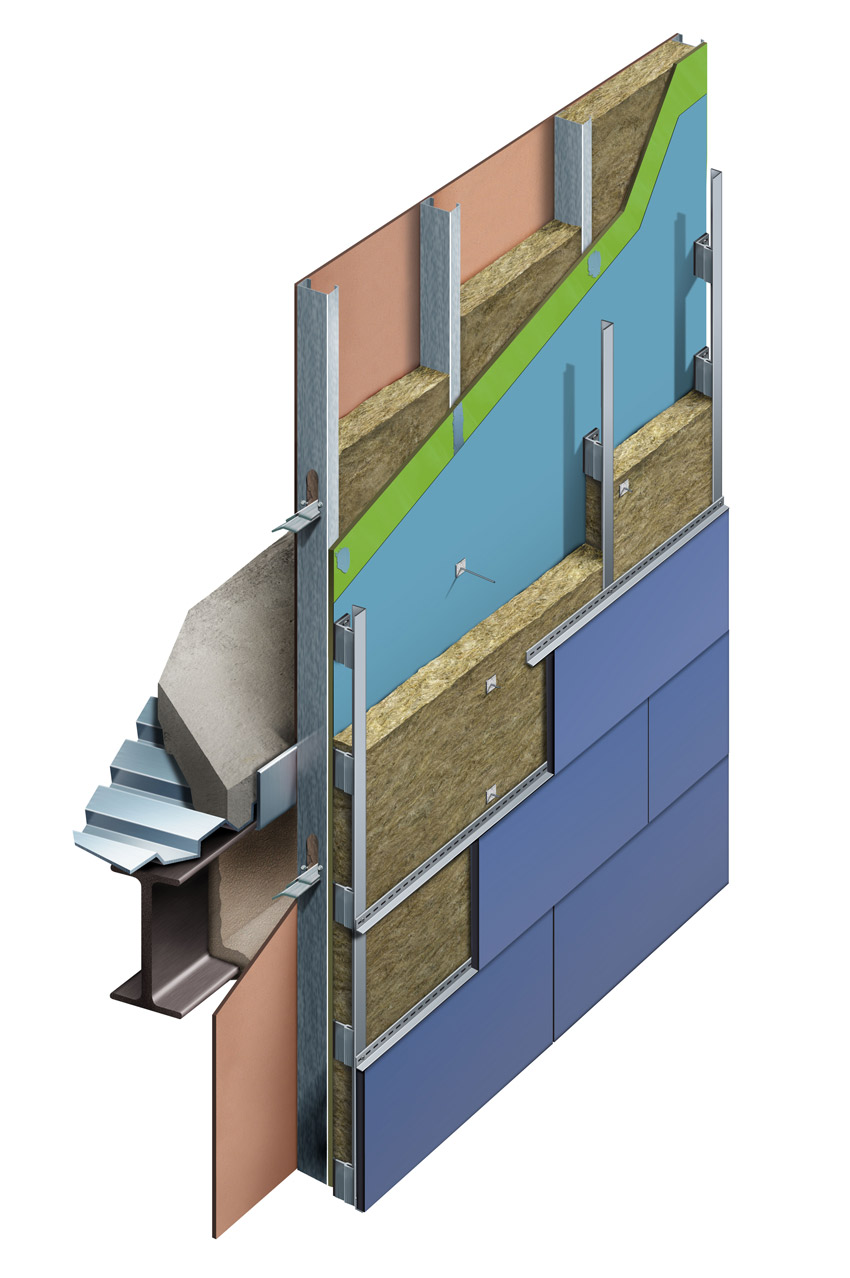
Due to thermal bridges such as framing members, the effective R-value of stud cavity insulation can be reduced by as much as 50 percent. In contrast, continuous insulation is often less subject to thermal bridges and can result in a much higher effective R-value. Both stud cavity insulation and ci can work together to provide significant thermal performance while minimizing wall thickness.
As the ASHRAE 90.1 definition suggests, continuous insulation is intended to minimize thermal bridging in exterior wall assemblies. Thermal bridging is the type of heat loss that occurs when heat flows through the building enclosure via a continuous path, such as wood framing or highly conductive steel framing members. (See the Thermal Performance of CI sidebar, which describes how framing can reduce thermal effectiveness of stud cavity insulation.)
Types of Continuous Insulation
There are several types of continuous insulation to choose from. This includes but is not limited to mineral wool, extruded polystyrene, polyisocyanurate, and spray foam. While each of these options provides some level of thermal resistance, they also feature substantial differences. For example, they offer varying degrees of fire resistance, moisture resistance, moisture vapor permeance, bendability, UV resistance, and sound absorption. Moreover, the sustainability attributes of ci can also be a key differentiator.
With multiple performance characteristics and product attributes to consider, selecting the right ci for a construction application is frequently determined by an assessment of strict must-have requirements balanced with some nice-to-have features.
Mineral Wool as Continuous Insulation
Mineral wool ci is a semi-rigid insulation board that is manufactured of bonded rock fibers. Since it is essentially born from rock, it is exceptionally fire resistant. In fact, it is one of the only (if not the only) noncombustible continuous insulation materials readily available in the United States. In addition to its inherent ability to help limit the spread of fire, mineral wool offers many other features and benefits (see following sections), which can make it a cost-effective choice for walls with CMU or steel frame backup. In addition, it can be used behind combustible and noncombustible cladding types, ranging from brick veneer and single-skin metal panel to high-pressure laminate and fiber cement.
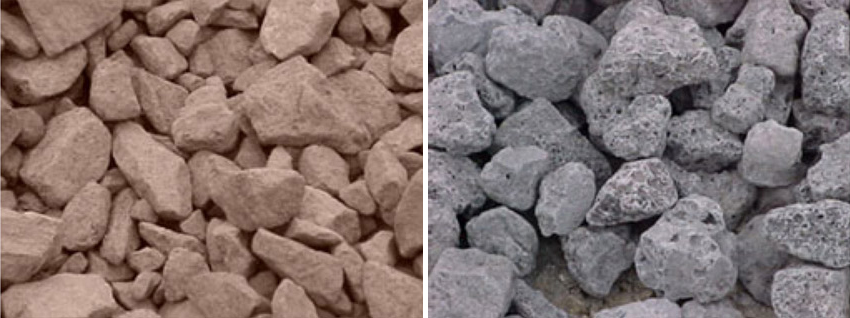
Natural rocks (left) and slag (right)
Raw Materials
Mineral wool was originally created using mined natural rock. However, over the years, the availability of low-cost by-products with similar chemical makeup as mined rock have been made available. One such raw material is a by-product of the steel industry called blast furnace slag, which is made up of spent iron ore and limestone. The use of slag allows mineral wool to achieve one of the highest recycled contents in the industry and thereby minimizes its environmental impact. Every year, the mineral wool industry recycles millions of tons of waste slag. In addition, unlike foam plastic insulation, mineral wool does not use any blowing agents or flame retardants in its production.
Manufacturing Process
Rock and slag are melted in cupola furnaces at temperatures exceeding 2,600 degrees Fahrenheit. Next, the molten lava is spun into fibers using compressed air and high-speed spinning wheels. This process may leave mineral wool with a high embodied energy status, but this is offset by the energy saved in the material’s use phase. For example, after only one month of use, 1 pound of mineral wool insulation saves the same amount of energy used in its manufacture. Because of the manufacturing process, mineral wool fibers can withstand high temperatures, which is why it has excellent fire-resistant properties.
Benefits
The advantages of using mineral wool as continuous insulation are many, including:
Fire performance. ASTM E 119 is a fire performance standard that tests building materials. The E 119 test is based on the time and temperature of a fire. Fires ramp up in temperature over time. The curve below illustrates how different building products perform.
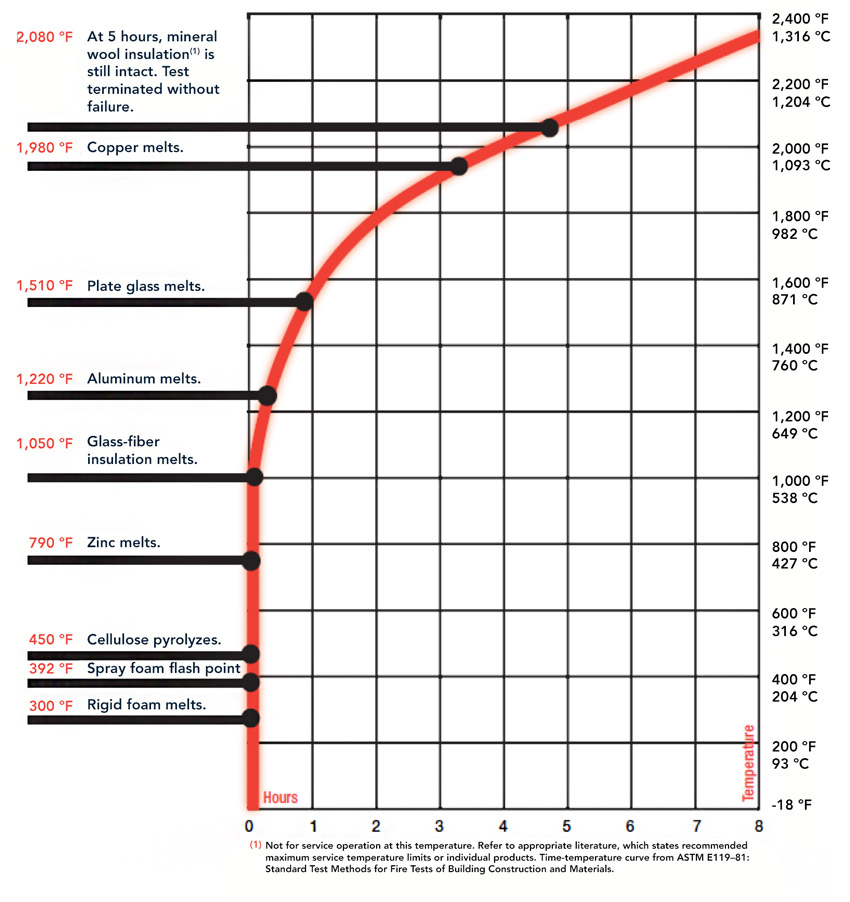
This chart compares a number of insulation products. At the very top of this chart, you can see that after 5 hours and temperatures over 2,000 degrees Fahrenheit, the test was stopped with the mineral wool insulation still intact.
Noncombustible and fire resistant. Mineral wool insulation is noncombustible and, in the event of a fire, it will not burn or release harmful smoke and hot gases. For these reasons, China’s building industry, which has experienced several high-profile and deadly fires directly attributed to the use of combustible insulation, has changed its building code to mandate the use of mineral wool in structures more than 26 meters tall.
Similarly, in the United States, mineral wool has been used for fire containment in multistory buildings for decades. For example, semi-rigid mineral wool is frequently used in fire-rated curtain wall assemblies to minimize the passage of flame and hot gases from the floor of origin to the floors above (Reference ASTM E 2307 for more information). More recently, mineral wool ci is being specified in cavity wall systems and open-joint facade assemblies because it can significantly limit the spread of fire across the exterior wall surfaces of a building as well. In fact, manufacturers of combustible claddings and air barriers often require mineral wool ci as part of their NFPA 285 compliant wall assemblies.
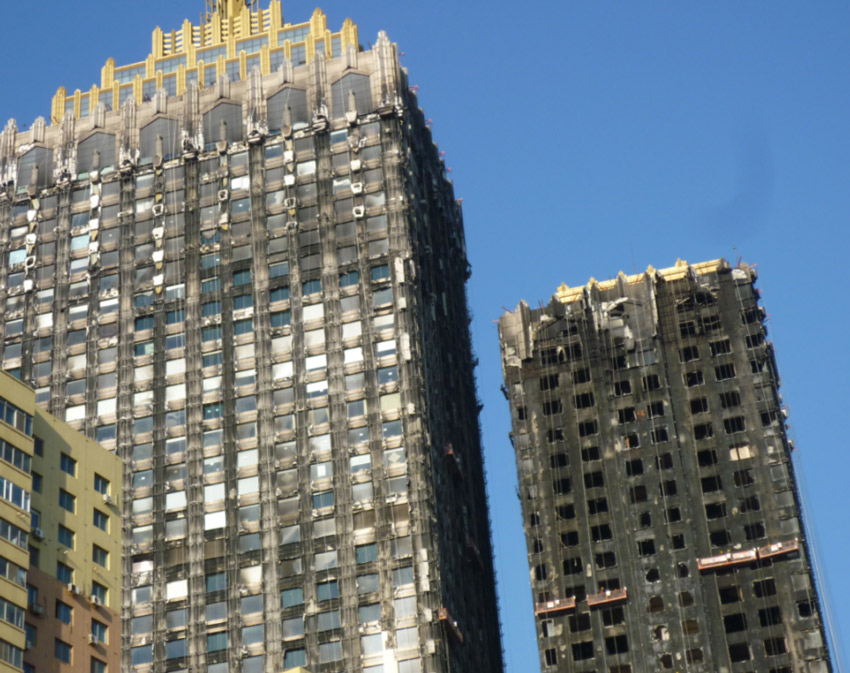
This 2011 photo of the Sheraton Hotel buildings in Shenyang, China, shows the aftermath of the fire that completely burned both of these buildings. Fires like this prompted China to begin requiring the use of mineral wool in exterior wall assemblies in all buildings more than 26 meters in height.
NFPA 285 Fire Test
NFPA 285 is an intermediate scale wall system fire test. It measures what happens during a fire when combustible materials such as foam plastic ci, combustible air barriers, or combustible claddings are included as part of the exterior wall assembly. This is not a new test. NFPA 285 has been featured in multiple sections of the International Building Code (IBC) for several years. However, it started to gain increased awareness when the energy standards, such as ASHRAE 90.1, began prescribing continuous insulation and requiring air barriers, both of which are sometimes combustible.
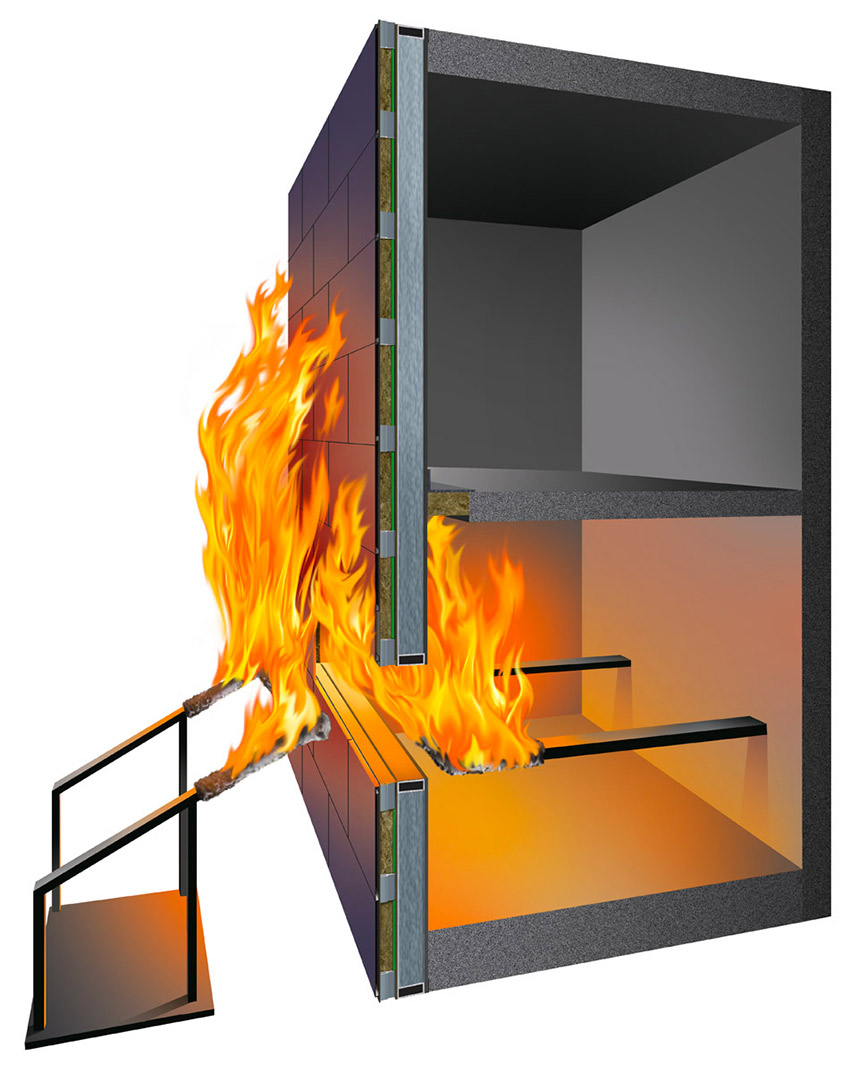
This illustration depicts the NFPA 285 fire test being conducted on a wall with mineral wool as the exterior wall cavity insulation as well as continuous insulation with a metal panel cladding.
The purpose of NFPA 285 is to limit fire spread via exterior wall surfaces, thereby enhancing the life safety of building occupants and protecting the building itself. Shown below are four examples of real building fires. They exhibit the types of fire spread that NFPA 285 aims to limit. None of these fires started within the exterior wall system; however, combustible materials allowed the fire to quickly spread up the structure.
The Address Downtown Dubai Hotel | Dubai, United Arab Emirates
Reports indicated that an electrical short circuit on a spotlight caused the major fire that engulfed The Address Downtown Dubai hotel on New Year’s Eve 2015. According to police, the blaze was triggered by a spark from cables connected to the light, which sat on a ledge between the 14th and 15th floors of the 63-story tower. Police concluded that the alarms did not sound immediately because the fire had started on the outside of the building, therefore smoke had not yet set off internal alarms.1
Wooshin Golden Suites | Busan, South Korea
In October 2010, the Wooshin Golden Suites apartment building in South Korea experienced a fire that started on the fourth floor in a garbage collection room. Reports indicate that the building had a working sprinkler system, but it is reported that the code didn’t require sprinklers in that room. According to reports, by the time the fire spread from the point of origination, it overwhelmed the sprinklers, traveled out a window, and spread up the exterior via combustible paint on aluminum wall panels.2
TVCC/Mandarin Oriental Hotel | Beijing, China
Reports blamed the February 2009 40-story office building fire in TVCC/Mandarin Oriental Hotel in Beijing, China, on fireworks that landed on the roof, igniting the roof and allowing the fire to spread from the top to the bottom of this building in approximately 13 minutes. The fire burned through the thin metal wall cladding and ignited the flammable insulation layer below the metal.3
Monte Carlo Resort & Casino | Las Vegas
In January 2008, fire investigators determined that workers on the roof with welding torches ignited combustible trim near the top of the exterior walls of the Monte Carlo Resort & Casino in Las Vegas. Reports say that the fire was a result of untested spray foam trim at the top of the building rather than the exterior insulation finish system over which it was installed. The fire spread across the exterior face of the building and burned out a large area of the upper floors of this building.4
These examples demonstrate the concern for combustible materials installed on the outside of buildings that are required by code to be noncombustible. It should be noted that NFPA 285 is an “assembly” test, not a product test. Accordingly, to achieve NFPA 285 compliance, the wall assembly constructed on the job site must match the exact assembly that was tested in the fire lab.
.jpg)
Clockwise from top left: Address Downtown Dubai Hotel, Monte Carlo Resort and Casino, Sheraton Hotel, Wooshin Golden Suites, and TVCC Mandarin Oriental Hotel
Thermal performance. Mineral wool insulation features an R-value of 4.3 per inch, and, in most U.S. climate zones, 1–2 inches of mineral wool ci will easily help meet the prescriptive R-value requirements outlined in the energy standards for above grade walls.
Furthermore, mineral wool retains 100 percent of its R-value over the long term, even after being exposed to moisture. When mineral wool is exposed to sustained moisture, it may exhibit a temporary reduction in R-value. However, when the insulation is dried and not mechanically changed in form, the thermal properties return to their original level.
To illustrate this, the thermal conductivity of a dry sample mineral wool was tested per ASTM C 518. Then, that same sample was submerged in water for 88 hours. While an actual wall assembly will likely never be submerged in water for 88 hours, this time frame enabled the voids between the mineral wool fibers to become completely saturated. Afterward, the insulation was allowed to dry. When dry, the thermal conductivity of the material was tested once again, and the results were identical to the first thermal conductivity test.
Moisture resistance. Mineral wool is engineered to repel and drain moisture in continuous insulation applications. It is designed to handle condensation, driving rain, and other moisture that may be introduced into the wall assembly. Some mineral wool insulation products are also designed to meet ASTM C 1104 compliance to demonstrate mineral wool’s moisture resistance. Most manufacturers have tested mineral wool to ASTM C 1104, which is the standard test method for determining the water vapor sorption of unfaced mineral fiber insulation. Further, due to mineral wool’s outstanding ability to drain and dry, moisture drains to the bottom and out the weeps. Therefore, water rarely migrates past the face of the insulation.
If subjected to a wet cavity wall condition, mineral wool fibers will not absorb or bond with water. However, water may temporarily enter voids in the fiber matrix and displace some air. As described above, mineral wool will drain and dry rapidly.
Sound attenuation. Another attribute that mineral wool products provide is sound attenuation. All mineral wool insulation blocks and absorbs sound passing between partition walls and floor/ceiling applications. Assemblies that include mineral wool are capable of providing sound transmission coefficients (STCs) that improve the indoor environmental quality for the occupants of a structure. (See also the Acoustics section later in this article.)
Durability/water repellency. Mineral wool continuous insulation products repel water and are demonstrate durability when exposed to the elements of weather. These properties make mineral wool an excellent product for open-joint facade construction. When mineral wool remains exposed to the weather and becomes wet, insulating value is reduced; however, when the insulation is dried and not mechanically changed in form, the thermal properties return to their original level. Other continuous insulation products also repel water but cannot be left exposed to UV for extended periods of time.
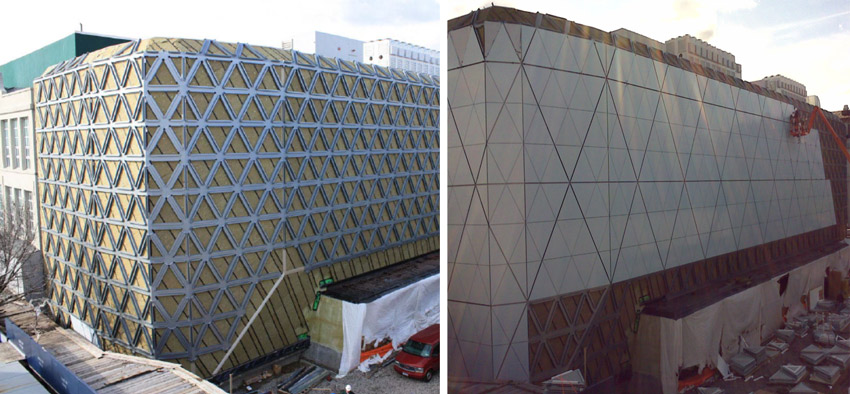
In a testament to the durability of mineral wool, these photos of the Museum of the Moving Image in Astoria, New York, were taken after this insulation had been left exposed for over four months through the New York winter. The insulation was exposed to UV rays, rain, sleet, snow, and ice, yet it remained intact and in great condition.
Air/vapor permeability. Mineral wool continuous insulation has a permeance rating of 50. Accordingly, it will enable incidental water/condensation/moisture within the wall assembly to dry towards the exterior.
Aesthetics. The natural color of mineral wool can provide some degree of camouflaging, which is often adequate for use in open-joint facades.
According to Angela M. Ogino, technical services leader for Thermafiber Inc., an Owens Corning Company, “In light of recent high-rise fires and concerns arising around fire protection, moisture, thermal, and durability, the product attributes offered by mineral wool provides a logical performance solution for the exterior continuous insulation application.”
Mineral Wool's Relationship to Standards and Codes
Below are the key codes and standards that define system interaction and key specification practices, designed to ensure that wall system designs are consistent with recent advances in building analysis, new code requirements, revised test methods, and a comprehensive systems approach to wall systems.
- NFPA 285: NFPA 285 is required in the International Building Code (IBC) in multiple situations. The NFPA 285 test is to determine that combustibles, when exposed to fire on the exterior face of the wall, do not spread flame over the surface or through the core of the otherwise noncombustible wall assembly.
- ASHRAE 90.1: ASHRAE 90.1 is a baseline building energy standard that may be adopted by states and local jurisdictions to regulate the design and construction of new buildings. The mandatory installation of ci over steel stud framing was first incorporated in the ASHRAE 90.1-1999 edition. Both residential and nonresidential commercial steel-framed walls in zones 3–8 required continuous insulation. Standard 90.1-2013 prescribes ci in all climate zones for steel frame construction and metal-framed buildings.
- International Energy Conservation Code (IECC): IECC addresses both residential and commercial buildings (90.1 is limited to commercial buildings).
Beyond the Code: Reducing Greenhouse Gas Emissions
Another important factor in increasing energy efficiency in buildings is reducing greenhouse gas emissions. According to a 2007 McKinsey study titled “Reducing U.S. Greenhouse Gas Emissions: How Much and at What Cost,” new commercial and residential building envelope improvements (including increased insulation levels) are identified as a negative marginal cost item—meaning that this option would generate “positive economic returns over its life cycle.” Many industry professionals feel that the insulation requirements set out in state-adopted codes are not enough to save energy and reduce greenhouse gas emissions. They look beyond the code initiatives to USGBC’s LEED rating system as well as ASHRAE Standard 189 or Architecture 2030.
Mineral Wool Insulation and LEED
In terms of mineral wool insulation’s potential product contributions to LEED, the following overview illustrates the benefits of the product in the Energy & Atmosphere, Materials & Resources, and Indoor Environmental Quality categories.
Energy & Atmosphere (EA)
Minimum Energy Performance Prerequisite 2
Mineral wool insulation helps reduce building energy demand. The project team is responsible for conducting energy analysis to determine the overall building energy efficiency.
Optimize Energy Performance
Mineral wool insulation helps reduce building energy demand. It’s dependent on U-value of construction assembly. The project team is responsible for conducting energy analysis to determine the overall building energy efficiency.
Materials & Resources (MR)
Building Product Disclosure & Optimization – Environmental Product Declaration
This credit calls for the use of 20 different permanently installed products sourced from at least five different manufacturers that have third-party certified EPD. Mineral wool insulation products carry third-party certified EPDs. See UL.com/EPD for certifications.
Raw Material Source and Extraction Reporting
Mineral wool insulation manufacturing plants extract raw materials and manufacture products in close proximity to many projects. The products may contain various levels of preconsumer recycled content. Some products have higher content, so check with manufacturers.
Building Product Disclosure and Optimization Material Ingredients
This credit also calls for the use of at least 20 different permanently installed products from at least five different manufacturers that demonstrate the chemical inventory of the product to at least 0.1 percent (1,000 ppm). Various mineral wool insulation products have material disclosure information such as Declare, Cradle to Cradle (at least Bronze), or Cradle to Cradle Material Health Certification (Bronze or higher), and at least 90 percent of materials are assessed by weight.
Construction and Demolition Waste Management
This credit considers the recycle or salvage of nonhazardous construction and demolition materials. Mineral wool insulation material can be removed from demolition projects and reused in new construction. Refer to manufacturer product specifications for recommended storage and installation of materials, specifications for recommended storage, and installation of materials.
Indoor Environmental Quality (EQ)
Thermal Comfort
Design HVAC systems and building envelope to meet ASHRAE Standard 55–2010: Thermal Comfort Conditions for Human Occupancy with errata or a local equivalent. Mineral wool insulation products contribute to a comfortable thermal environment.
Low Emitting Materials (EQ)
This credit includes requirements for product manufacturing as well as project teams. It covers volatile organic compound (VOC) emissions in the indoor air and the VOC content of materials, as well as the testing methods by which indoor VOC emissions are determined. The introduction of mineral wool made without formaldehyde addresses this credit area.
Mold Resistance
Mineral wool insulation products do not promote mold growth when tested in accordance with ASTM standards. See individual product data sheets for details.
Indoor Environmental Quality (EQ) – For Schools Only
Minimum Acoustic Performance Prerequisite 3
Mineral wool insulation products absorb noise passing between floors and walls and provide STCs that improve the indoor environmental quality through acoustical performance for building occupants.
Acoustic Performance
Mineral wool insulation products absorb noise passing between floors and walls and provide STCs that improve the indoor environmental quality for building occupants. This can contribute to design of classrooms and other core learning spaces to meet the sound transmission class (STC) requirements of ANSI S12.60–2010 Part 1 or a local equivalent.
Acoustics
One attribute that mineral wool products provide is sound attenuation. Mineral wool has a long history of success with improving indoor acoustics. All mineral wool insulation blocks and absorbs sound passing between partition walls and floor/ceiling applications. Assemblies that include mineral wool are capable of providing sound transmission coefficients (STCs) that improve the indoor environmental quality for the occupants of a structure. Furthermore, it could be surmised that using insulation with sound-control properties on the exterior of the building can help to improve the indoor environmental quality by reducing the amount of noise coming in from outside the building.
The chart below describes the noise reduction coefficient of different thicknesses of a typical mineral wool. The NRC is a number used for rating how a particular material absorbs sound. It is determined through laboratory testing. The number ranges from zero (perfectly reflective) to 1 (perfectly absorptive), and some materials can test above 1.
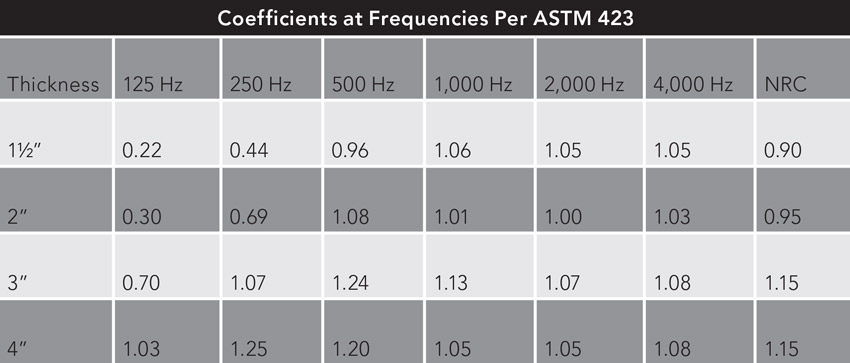
Rinscreen and Cavity Wall Assemblies
One of the prime uses of mineral wool insulation is in rainscreen and cavity wall designs. Commonly used in Europe, these assemblies create an air/drainage cavity that prevents water ingress and allows pressure equalization. There are a number of options for mineral wool insulation use in a rainscreen design. It can be used in both permeable and nonpermeable assemblies. The graphic below illustrates a vapor permeable design.
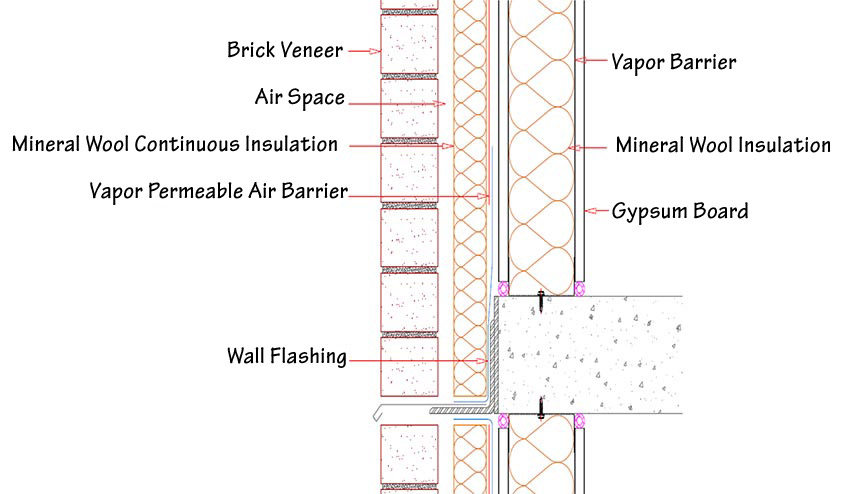
This next image is an example of a vapor nonpermeable assembly. Vapor retarders, air barriers, and moisture control are elements that are essential to the proper design and construction of buildings.
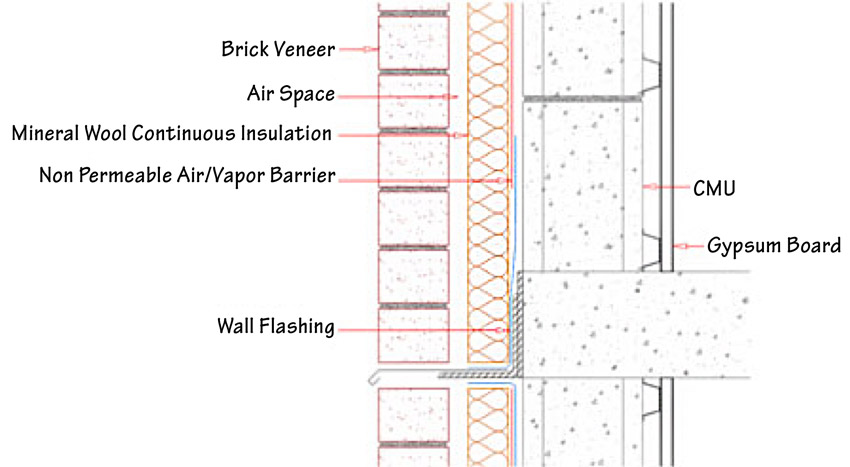
The need for, and proper placement of, the vapor/air barrier and moisture control must be determined by a qualified professional engineer/architect. Critical considerations include the inside and outside climatic and air pressure conditions of the building. In addition, any penetrations of the vapor/air barrier for mechanical insulation attachment must be approved by the air/vapor barrier manufacturer.
Below is an example of an open-joint assembly. Here, the use of UV-resistant mineral wool is for the durability of the assembly and no loss of R-value. Walls without ci are subject to up to 50 percent loss of effective R-value.
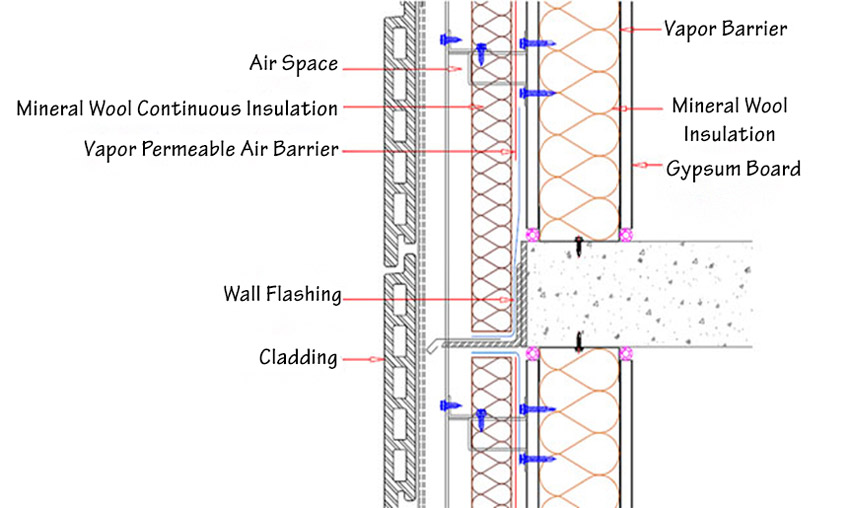
Installation
Rainscreen and cavity wall systems vary greatly from types of hangers to how they are installed. As a semi-rigid product, mineral wool is easy to cut and install, and its flexibility allows it to conform to building shapes and construction irregularities. It comes in standard-sized sheets and is easily cut with a serrated knife.
Generally, mineral wool insulation is installed with abutted joints and mechanically secured and attached to the building substrate. Note that the joints do not need to be taped; mineral wool leaves a clean, straight edge when cut. A 1-inch air gap is required between the insulation and the brick veneer for a masonry exterior wall application regardless of the type of insulation installed within the wall cavity.
Tradeoffs exist when selecting continuous insulation for a particular assembly. For example, unlike rigid foam, mineral wool flexes for a better fit on curved walls and other surfaces.
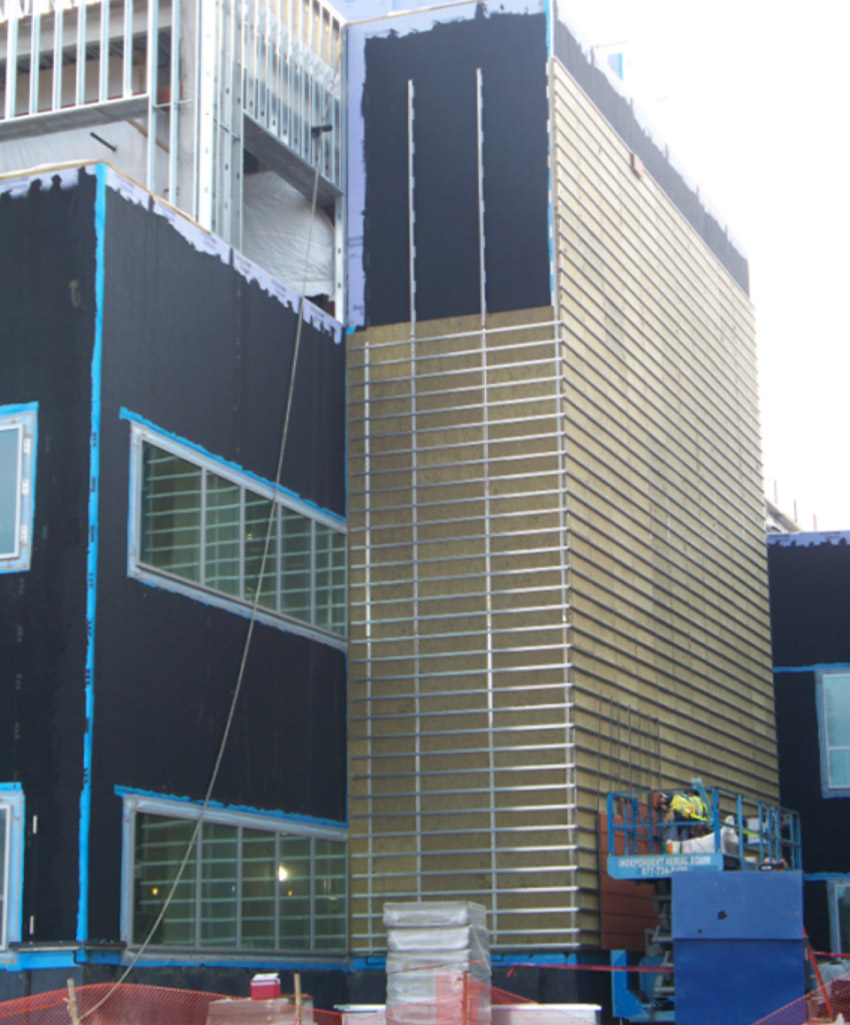
Shown here on the Fort Belvoir Community Hospital in Fort Belvoir, Virginia, mineral wool is being installed in a steel stud and gypsum board exterior construction. The material is being installed behind the grid structure that will hold the terra cotta facade panels.
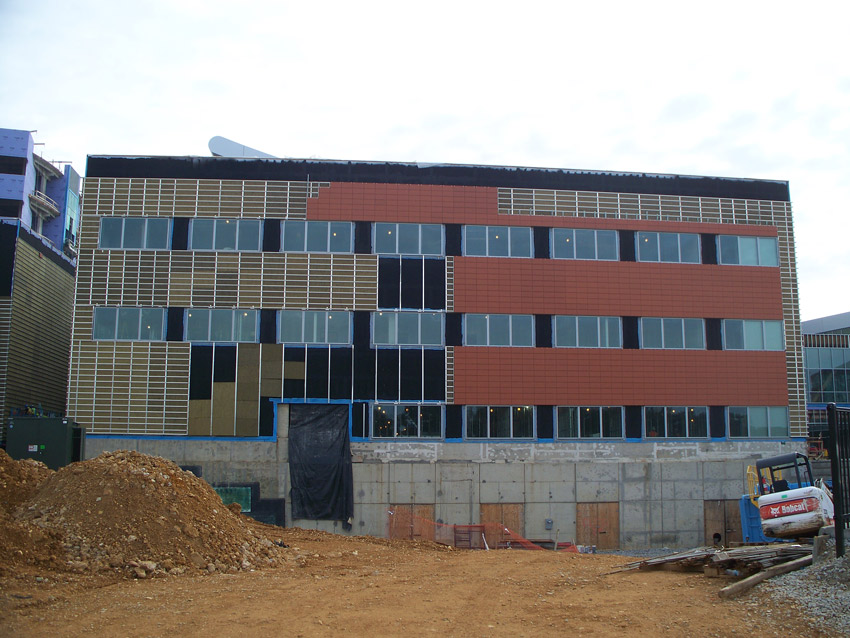
This is the same Fort Belvoir Community Hospital project where the workers are installing the terra cotta facade panels over the mineral wool insulation.
Insulation is friction-fitted between the wall ties in masonry applications, as shown in the top image. After installing the insulation, the installer would secure with a clip, utilizing the center notches to secure directly on the tie as shown. If using a flange or flat-style hanger, installation of insulation is friction-fit between ties, forming a seam (a typical size is 16 inches on center).

The North Quad project on the University of Michigan campus in Ann Arbor, Michigan, is a typical masonry cavity wall construction. In this photo, you can see the masons installing the mineral wool insulation in the masonry cavity and securing it with retaining clips that fasten to the masonry wall ties. Note the very tight seams, especially around the brick ties. No taping or extra forming is necessary.
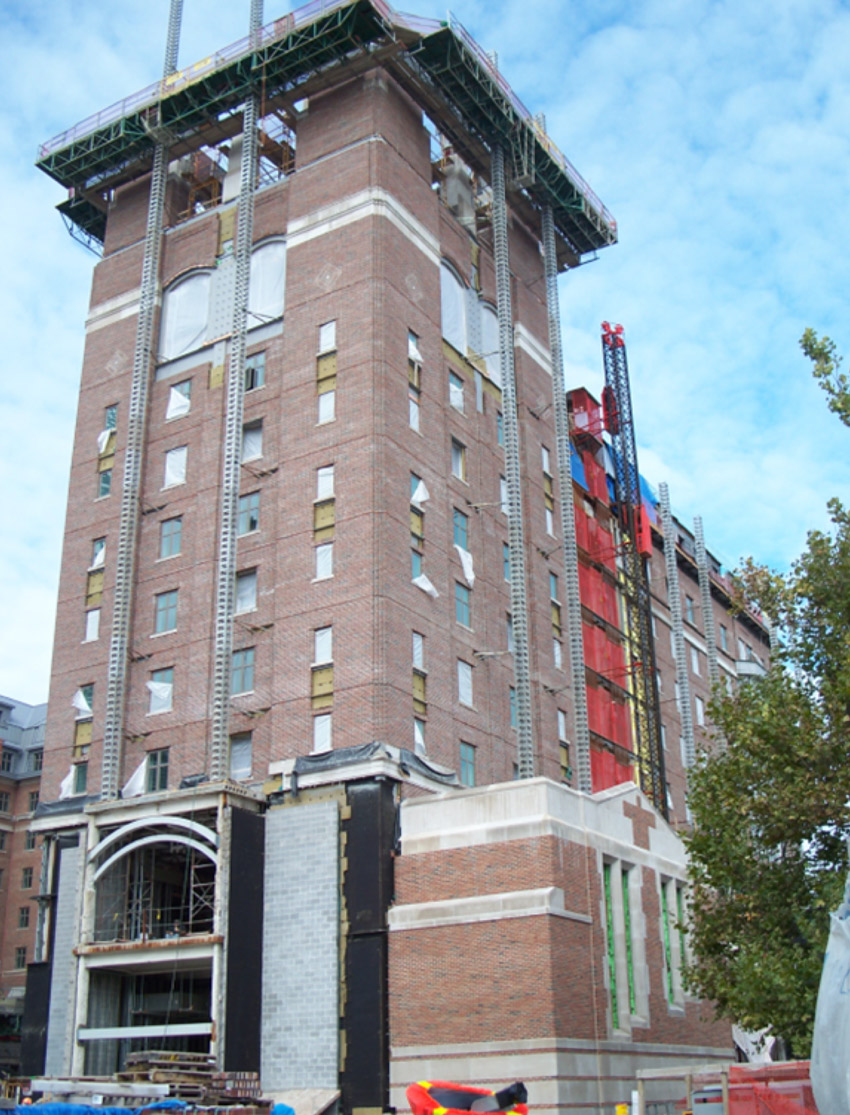
Here, the insulation is fully installed on the North Quad project. It can be seen through the unfinished openings below the windows.
Safety of Installation
Mineral wool is manufactured in sizes that are safe and easy to handle on the job site, and it can be safely installed with regular construction scaffolding or mechanical lifts. Additionally, mineral wool does not pose any safety threats to the insulation installers.
Trends/Improvements/Innovation
There is a trend to reduce thermal shorts regarding continuous insulation with the emergence of several thermally isolating hangers on the market. The use of these systems allows the insulation to be continuous and uninterrupted so as to realize the full benefit of the prescribed R-Value.
Key Points to Remember
As we conclude, let’s quickly recap the most important points and benefits regarding using mineral wood as continuous insulation.
- ASHRAE 90.1 defines continuous insulation as “insulation that is continuous across all structural members without thermal bridges other than fasteners and service openings. It is installed on the interior, exterior, or is integral to any opaque surface of the building.”
- Use of continuous insulation minimizes thermal bridging and can have a dramatic impact on the energy efficiency of a building envelope.
- Mineral wool has a high recycled content due to the composition of the natural composition of the fibers.
- Mineral wool provides a cost-effective continuous insulation solution.
- Mineral wool continuous insulation is durable, moisture resistant, flexible, UV resistant, noncombustible with a melt point above 2,000 degrees Fahrenheit, and air/vapor permeable.
- Mineral wool is a semi-rigid product that is easy to cut and install, and it can be used in both permeable and nonpermeable assemblies.
- Assemblies that include mineral wool are capable of providing sound transmission coefficients (STCs) that improve the indoor acoustical environmental quality for the occupants of a structure.
- Mineral wool continuous insulation is capable of contributing to a number of LEED credit categories.
End Notes
1Moukhallati, Dana. “Electrical fault caused The Address Downtown Dubai hotel fire.” The National. 20 January 2016. Web. 9 April 2018.
2Myo-ja, Ser and Sang-jin, Kim. “Fire turns luxury apartments into towering inferno.” Korea JoongAng Daily. 2 October 2010. Web. 9 April 2018.
3Schwankert, Steven. “Five Years Ago Today: The CCTV Hotel Tower Burns.” The Beijinger. 9 February 2014. Web. 9 April 2018.
4“Fire Breaks Out at Monte Carlo Resort on Las Vegas Strip.” Fox News. 25 January 2008. Web. 9 April 2018.
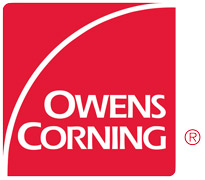
|
Owens Corning develops, manufactures, and markets insulation, roofing, and composites. The company’s businesses use their deep expertise in materials, manufacturing, and building science to develop products and systems that save energy and improve comfort in commercial and residential buildings. www.owenscorning.com |

